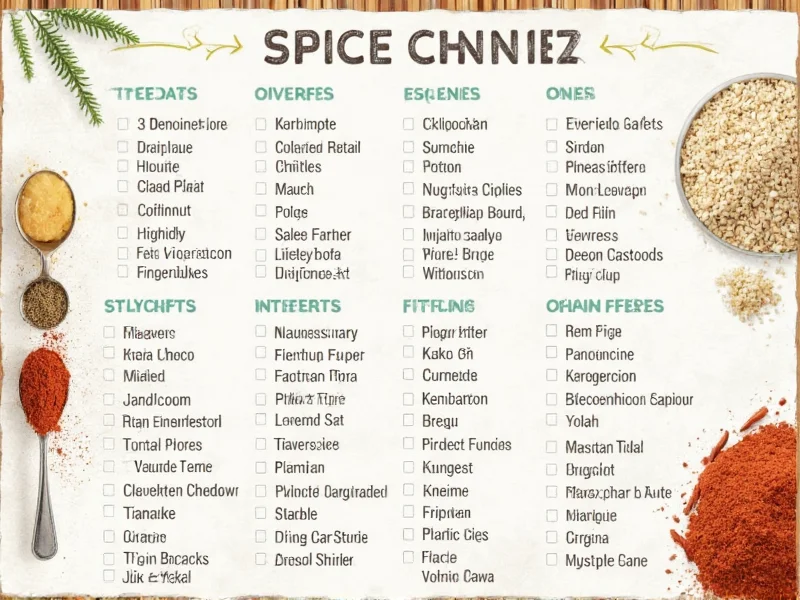The essential spice list for kitchen beginners includes salt, black pepper, garlic powder, onion powder, paprika, cumin, oregano, cinnamon, red pepper flakes, and cayenne pepper. These 10 foundational spices cover most cooking needs across various cuisines and form the basis of a versatile spice collection that can be expanded as your cooking skills develop.
Building a well-rounded spice collection transforms ordinary cooking into extraordinary culinary experiences. The right spices don't just add flavor—they create depth, balance, and complexity in dishes while connecting us to global food traditions. This guide provides a practical approach to establishing your kitchen spice collection, focusing on versatility, value, and everyday usability rather than overwhelming beginners with unnecessary options.
Why a Thoughtful Spice Collection Matters
Quality spices serve as your culinary foundation, allowing you to elevate simple ingredients into memorable meals. Unlike pre-made seasoning blends that often contain fillers and excessive salt, individual spices give you complete control over flavor profiles. A well-curated spice rack reduces reliance on processed foods while expanding your cooking repertoire across multiple cuisines. The investment in quality spices pays dividends through enhanced nutrition, reduced food waste, and the satisfaction of creating restaurant-quality meals at home.
The Essential 10: Core Spices for Every Kitchen
Starting with these ten versatile spices provides coverage for most cooking scenarios while preventing the common beginner mistake of accumulating rarely used bottles. Each selection serves multiple purposes across various cuisines:
| Spice | Flavor Profile | Primary Uses | Storage Tip |
|---|---|---|---|
| Kosher Salt | Clean, pure salinity | Seasoning all dishes, brining | Store in airtight container away from humidity |
| Whole Black Pepper | Earthy, pungent, floral notes | Finishing dishes, sauces, marinades | Keep in whole peppercorn form until use |
| Smoked Paprika | Rich, smoky, slightly sweet | Stews, rubs, roasted vegetables | Refrigerate after opening for longevity |
| Ground Cumin | Earthy, warm, slightly citrusy | Tacos, chili, curries, roasted meats | Buy in small quantities, use within 6 months |
| Dried Oregano | Robust, slightly bitter, herbal | Pizza, pasta sauces, Mediterranean dishes | Crush between fingers before adding to dishes |
Building Your Collection Strategically
Approach spice acquisition like building a culinary toolkit—add purposefully rather than collecting indiscriminately. Start with the essential 10, then expand based on your cooking habits. If you frequently make Italian dishes, add basil and rosemary. For Indian cuisine enthusiasts, consider turmeric and cardamom. This targeted approach prevents the common pitfall of accumulating expensive but rarely used spices.
When purchasing spices, prioritize quality over quantity. Whole spices maintain freshness significantly longer than ground varieties—invest in a small spice grinder for optimal flavor. Purchase from stores with high turnover to ensure freshness, and always check for vibrant color and strong aroma. Proper storage in airtight containers away from heat and light extends shelf life considerably.
Maximizing Flavor Impact
Understanding when and how to use spices transforms good cooking into exceptional meals. Add dried herbs early in the cooking process to allow flavors to meld, while delicate spices like saffron work best added near the end. Toast whole spices in a dry pan before grinding to unlock complex flavors. Remember that spice potency varies by brand and age—always taste as you season rather than following measurements blindly.
Develop your palate by experimenting with spice combinations. The classic French blend herbes de Provence (thyme, rosemary, oregano, marjoram) works beautifully with roasted vegetables, while the Middle Eastern za'atar (thyme, sumac, sesame seeds) elevates simple flatbreads. Keep a cooking journal to note successful pairings for future reference.
Avoiding Common Spice Mistakes
Many home cooks unknowingly compromise their dishes through improper spice handling. Never add spices directly over a steaming pot—moisture causes clumping and reduces shelf life. Avoid the 'shake test' where you sprinkle spices without tasting first; instead, mix small amounts in a spoon with a bit of oil to assess flavor before adding to dishes.
Understand that 'spicy' doesn't always mean 'hot'—many essential spices like cumin and coriander add depth without heat. Don't confuse similar-looking spices; paprika and chili powder may appear identical but serve different culinary purposes. Finally, recognize that spices have shelf lives—ground spices typically remain potent for 6-12 months, while whole spices last 1-2 years.
Expanding Beyond the Basics
Once comfortable with the essential 10, consider these valuable additions based on your cooking interests:
- Cardamom: Essential for Scandinavian baking and Indian curries
- Sumac: Adds citrusy tang to Middle Eastern dishes
- Fennel seeds: Perfect for Italian sausages and roasted vegetables
- Star anise: Key component in Chinese five-spice and braising liquids
- Mustard seeds: Foundation for Indian tempering techniques
When exploring international cuisines, research authentic spice combinations rather than substituting from your basic collection. Many traditional dishes rely on specific spice ratios that create distinctive flavor profiles impossible to replicate with substitutions.











 浙公网安备
33010002000092号
浙公网安备
33010002000092号 浙B2-20120091-4
浙B2-20120091-4